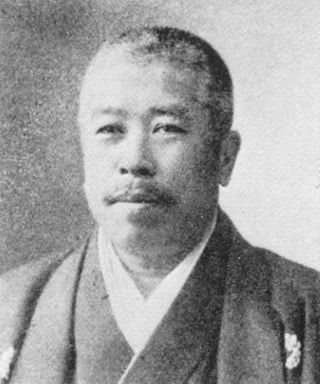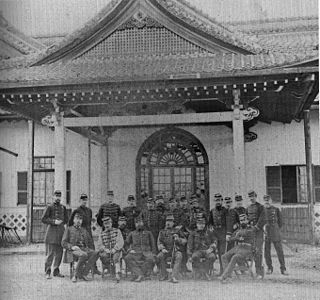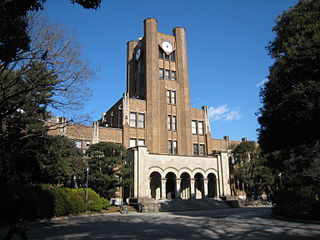
Education in the Empire of Japan was a high priority for its government, as the leadership of the early Meiji government realized the need for universal public education in its drive to modernize the nation.

Education in the Empire of Japan was a high priority for its government, as the leadership of the early Meiji government realized the need for universal public education in its drive to modernize the nation.
During the Edo period, education that were given to the commoners and outcasts were limited to none. What these low-class people did learn was generally geared towards the basic and practical subjects such as reading, writing, and arithmetic. [1] By the late 1860s, the Meiji leaders had established a system that declared equality in education for all in the process of modernizing the country.
After 1868 new leadership set Japan on a rapid course of modernization. The Meiji leaders established a public education system to modernize the country. Missions like the Iwakura mission were sent abroad to study the education systems of leading Western countries. They returned with the ideas of decentralization, local school boards, and teacher autonomy. [2] [3] Such ideas and ambitious initial plans, however, proved very difficult to carry out. After some trial and error, a new national education system emerged. As an indication of its success, elementary school enrollments climbed from about 30% percent of the school-age population in the 1870s to more than 90 percent by 1900, despite strong public protest, especially against school fees.
In 1871, the Ministry of Education was established. Elementary school was made compulsory from 1872, [4] and was intended to create loyal subjects of the Emperor. Middle Schools were preparatory schools for students destined to enter one of the Imperial Universities, and the Imperial Universities were intended to create westernized leaders who would be able to direct the modernization of Japan. In December, 1885, the cabinet system of government was established, and Mori Arinori became the first Minister of Education of Japan. Mori, together with Inoue Kowashi created the foundation of the Empire of Japan's educational system by issuing a series of orders from 1886. These laws established an elementary school system, middle school system, normal school system and an imperial university system. With the aid of foreign advisors, such as American educators David Murray and Marion McCarrell Scott, normal schools for teacher education were also created in each prefecture. Other advisors, such as George Adams Leland, were recruited to create specific types of curriculum.
By 1890, Imperial Rescript on Education was signed to articulate government policy on the guiding principles of education on the Empire of Japan. The Imperial Rescript along with highly centralized government control over education, largely guided Japanese education until the end of World War II.
With the increasing industrialization of Japan, demand increased for higher education and vocational training. Inoue Kowashi, who followed Mori as Minister of Education established a state vocational school system, and also promoted women's education through a separate girls' school system.
Compulsory education was extended to six years in 1907. According to the new laws, textbooks could only be issued upon the approval of the Ministry of Education. The curriculum was centered on moral education (mostly aimed at instilling patriotism), mathematics, design, reading and writing, composition, Japanese calligraphy, Japanese history, geography, science, drawing, singing, and physical education. All children of the same age learned each subject from the same series of textbook.

During the Taishō and early Shōwa periods, from 1912-1937, the education system in Japan became increasingly centralized. From 1917-1919, the government created the Extraordinary Council on Education (臨時教育会議, Rinji Kyōiku Kaigi), which issued numerous reports and recommendations on educational reform. One of the main emphases of the Council was in higher education. Prior to 1918, "university" was synonymous with "imperial university", but as a result of the Council, many private universities obtained officially recognized status. The Council also introduced subsidies for families too poor to afford the tuitions for compulsory education, and also pushed for more emphasis on moral education.

During this period, socialism and communism exerted influences on teachers and teaching methods. The New Educational Movement (新教育運動, Shin Kyōiku Undō) led to teachers unions and student protest movements against the nationalist educational curriculum. The government responded with increased repression, and adding some influences from the German system in an attempt to increase the patriotic spirit and step up the militarization of Japan. The Imperial Rescript to Soldiers and Sailors became compulsory reading for students during this period.
Specialized schools for the blind and for the deaf were established as early as 1878, and were regulated and standardized by the government in the Blind, Deaf and Dumb Schools Order of 1926. Blind people were encouraged toward vocations such as massage, acupuncture, physical therapy, and piano tuning.
After the Manchurian Incident of 1931, the curriculum of the national educational system became increasingly nationalistic and after the start of the Second Sino-Japanese War in 1937, the curriculum became increasingly militaristic and was influenced by ultranationalist Education Minister Sadao Araki.
In 1941, elementary schools were renamed National People's Schools (国民学校, Kokumin Gakkō, translated from German Volksschule ) and students were required to attend Youth Schools (青年学校, Seinen Gakkō) vocational training schools on graduation, which mixed vocational and basic military training (for boys) and home economics (for girls). The Seinen Gakkō also conducted classes at night for working boys and girls.
Normal schools were renamed Specialized Schools (専門学校, Senmon Gakkō), and were often affiliated with a university. The Senmon Gakkō taught medicine, law, economics, commerce, agricultural science, engineering or business management. The aim of the Senmon Gakkō was to produce a professional class, rather than intellectual elite. In the pre-war period, all higher school for women were Senmon Gakkō.
After the start of the Pacific War in 1941, nationalistic and militaristic indoctrination were further strengthened. Textbooks such as the Kokutai no Hongi became required to be read. The principal educational objective was teaching the traditional national political values, religion and morality. This had prevailed from the Meiji period. The Japanese state modernized organizationally, but preserved its national idiosyncrasies. Emphasis was laid on the Emperor worship cult, and loyalty to the most important values of the nation, and the importance of ancient military virtues.
After the surrender of Japan in 1945, the United States Education Missions to Japan in 1946 and again in 1950 under the direction of the American occupation authorities abolished the old educational framework and established the foundation of Japan's post-war educational system.

Saishū Onoe was the pen name of Hachirō Onoe, a Japanese tanka poet, educator, and calligrapher.

The Imperial Rescript on Education, or IRE for short, was signed by Emperor Meiji of Japan on 30 October 1890 to articulate government policy on the guiding principles of education on the Empire of Japan. The 315 character document was read aloud at all important school events, and students were required to study and memorize the text.

Hiroshima University is a Japanese national university located in Higashihiroshima and Hiroshima, Japan. Established in 1929, it was chartered as a university in 1949 following the merge of a number of national educational institutions.

The Imperial Household Agency (IHA) is an agency of the government of Japan in charge of state matters concerning the Imperial Family, and also the keeping of the Privy Seal and State Seal of Japan. From around the 8th century AD, up until the Second World War, it was known as the Imperial Household Ministry.

Kagoshima University, abbreviated to Kadai (鹿大), is a Japanese national university located in Kagoshima, Kagoshima Prefecture, Japan.

Shiga Shigetaka was the editor of the magazine Nihonjin during the Meiji period, in which he argued against extreme Westernization.

The 1872–1880 French military mission to Japan was the second French military mission to that country and the first sent by the Third Republic. It followed the first French military mission to Japan (1867–68), which had ended with the Boshin War and the establishment of the rule of Emperor Meiji.
Diploma in Japanese has 2 meanings. They can be translated into "Senmonshi"(Japanese:専門士), the Japanese original academic degree, and the certificate of graduation.
Japanese people in China are Japanese expatriates and emigrants and their descendants residing in Greater China. In October 2018, there were 171,763 Japanese nationals living in the People's Republic of China, and 24,280 Japanese nationals living in the Republic of China (Taiwan).

A Gokoku Shrine is a shrine dedicated to the spirit of those who died for the nation. They were renamed from Shōkonsha (招魂社) in 1939. Before World War II, they were under the jurisdiction of the Ministry of the Interior, but after World War II they are administered by an independent religious corporation. Designated Gokoku Shrines were built in prefectures except Tokyo and Kanagawa Prefecture. The main deities are war dead from the prefecture or those who are related to them, as well as self-defense officers, police officers, firefighters, and others killed in the line of duty.
A miscellaneous school is a classification of schools under the education laws of Japan and South Korea.
Maruoka Kanji was Governor of Okinawa Prefecture (1888–1892) and governor of Kōchi Prefecture (1892).
Polytechnic schools in Japan are vocational education institutions for short and long term programs, a group of public human resources development facilities under paragraph (1) (i) of Article 15-6 of the Human Resources Development Promotion Law. It involves designated private sector as well.

Higher school was an institution of higher education in Japan, which was a preparatory institution for imperial universities and national medical colleges until the educational reform in occupied Japan.
Secular Shrine Theory or Jinja hishūkyōron (神社非宗教論) was a religious policy and political theory that arose in Japan during the 19th and early 20th centuries due to the separation of church and state of the Meiji Government. It was the idea that Shinto Shrines were secular in their nature rather than religious, and that Shinto was not a religion, but rather a secular set of Japanese national traditions. This was linked to State Shinto and the idea that the state controlling and enforcing Shinto was not a violation of freedom of religion. It was subject to immense debate over this time and ultimately declined and disappeared during the Shōwa era.
Kyodo Shoku (教導職) is a religious official established in the Empire of Japan for the Proclamation of the Great Doctrine. The institution showed little success and was abolished in 1884.

The Office of Japanese Classics Research was a central government organization for the training of the Shinto priesthood in Japan. It was established by the Meiji Government in 1882 as the successor organization to the Bureau of Shinto Affairs. Prince Arisugawa Takahito was its first leader.
The Bureau of Religions is one of the Internal departments of the Ministry of the Interior during the pre-World War I period and later the Ministry of Education, Science, Sports and Culture in Japan.
Pi is 3 is a misunderstanding that the Japanese public believed that, due to the revision of the Japanese Curriculum guideline in 2002, the approximate value of pi (π), which had previously been taught as 3.14, is now taught as 3 in arithmetic education. In fact, this is not true, and even after the revision, the approximate value of pi is still taught as 3.14.
Murakumo was the lead ship of six Murakumo-class destroyers, built for the Imperial Japanese Navy in the late 1890s. Murakumo took part in the Japanese response to the Boxer Rebellion (1900), saw action in several major engagements during the Russo-Japanese War (1904–1905), and served during World War I (1914–1918).